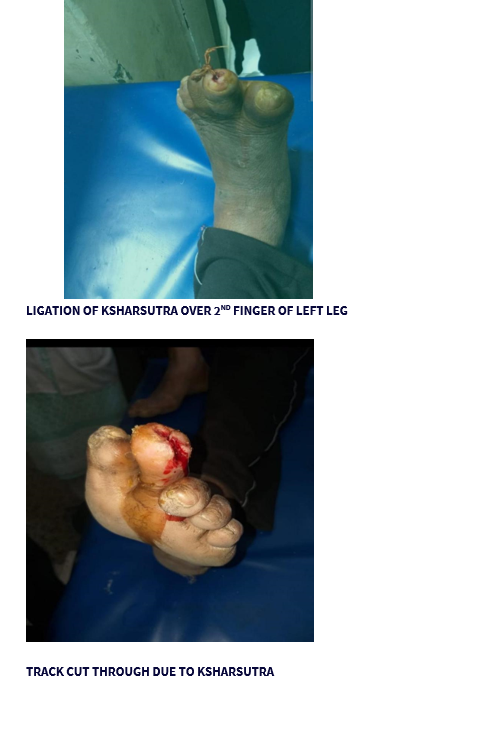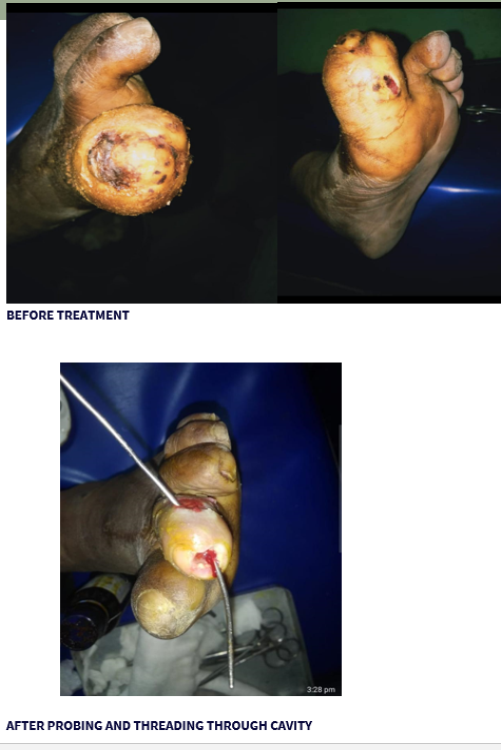Case Report
Year: 2024 |Volume: 5 | Issue: 01 |Pages: 31-37
EFFICACY OF KSHARSUTRA ON DUSHTAVRANA {NON HEALING ULCER}-A CASE STUDY
About Author
Correspondence Address:
Dr. Rushali Masane PG scholar, shalyatantra department; Vidarbha ayurvedic mahavidyalaya, Amaravati
Date of Acceptance: 2024-01-16
Date of Publication:2024-02-28
Article-ID:IJIM_287_03_24 http://ijim.co.in
Source of Support: Nill
Conflict of Interest: Nill
How To Cite This Article: Masane R, kalmegh M, joshi K, Chaudhari K. Efficacy Of Ksharsutra On Dushtavrana {Non Healing Ulcer}-A Case Study Int J Ind Med 2024;5(1): 31-37 DOI: http://doi.org/10.55552/IJIM.2024.5105
Abstract
Ulcer and wound managements have prime importance in the eld of surgical practice, it continuous as a challenge from ancient to modern era due to its diversity in onset and management hurdles. Healing is a mechanism where the body attempts to regain the integrity of injured part. Many factors like systemic illness, malnutrition, vascular insuffciency may delay the process of healing. In Ayurveda many procedures and different formulations are enumerated for Vrana management by our Acharyas. In Sushruta Samhita Acharya elaborated about Vrana, Dushtavrana and its 60 types of treatment modalities. Use of ksharsutra is a unique parasurgical procedure one among them and it works as potent debriding agent enhances formation of healthy granulation tissue and proper healing. Ksharsutra application is one of the most effective treatments in ayurveda. The numerous qualities of kshar, such as chedan, bhedan, lekhana, ropan, and pachan, helps in simultaneous track cutting and healing.A case report of 68 year old man presenting with non- healing ulcers at 2nd finger of left toe and greater toe with pus discharge ,unpleasant smell ,inflammation has been presented here.
Keywords: Vrana , dushtavrana ,kshar
Introduction
Since the beginning of time, humans have struggled with injuries and their healing processes. Every person's life begins with a little wound that remains visible as their umbilicus. Due to a variety of traumas, pathological insults, infections, physical and chemical exposures, and metabolic abnormalities, the frequency of non-healing ulcers is horribly high1. This presents a tremendous challenge to the medical field even today. According to estimates, about 10% of people will experience chronic ulcers at some point in their lives, with a 2.5% death risk.2 In order to address these issues, medical professionals propose quick, easy, and low-risk treatments for the same conditions. Regaining normalcy is the goal of mending a non-healing ulcer, and both modern and Ayurvedic medicine offer various care strategies to help achieve this.Even though there are many new advancements in the field of ulcer management in the modern era, Ayurvedic concepts regarding Vrana and Dushtavarana management have their own paramount importance. It is now imperative to elevate the effective methodologies and protocols mentioned in our science, spread better living conditions, and keep people healthy.
Acharya Sushruta explained the characteristics of Dushtavrana, such as Atisamvruta, Ativivruta, Atikatina, Atimrudu, Utsannam, Avasannam, Pootipooyasrava,Atyartavedana, Daha, Paka, Kandu, and Deergakalanubandhi. Acharya Sushruta gave the Vrana and its management a higher place.These characteristics are exactly the same as those of chronic, nonhealing ulcers.Even though mending is a natural process, Dosha Dhatu Dushti lDushtavrana causes it to be delayed. One of the main methods for clearing the wounds and promoting healing is debridement.Shashtiupakrama was formulated by Acharya Sushruta specifically to handle the various phases of Vrana.
It aids in achieving appropriate Shuddhavastha and It helps achieve appropriate Shuddhavastha and Roodavastha of Vrana with restoration of normalcy. It comprises many forms of Upakrama for Vranashodhana, Vranaropana, and Vaikrutapaha, such as medicinal, Panchakarma, surgical, and para-surgical therapies Ksharakarma is one of the best treatment modality for Dushtavrana because Kshara possess the special karma of Ksharana and Kshanana and is most important among Shastra and Anushastra due to its Chedya, Bedya ,Lekhya, Tridoshagnatwa and Visheshakriyatav properties.
Acharya sushruta specically mentioned that Vrana with Utsanna Katinamamsa, Kandu, Chirothita, and Dushoddhya should be cleansed by Ksharakarma due to debridement of slough tissue and promote quick healing. Also Acharya mentioned different kind of medicinal plants for the preparation of Ksharasutra such as arka sheer ,snuhiksheer and haridra.
Case Study
A 68 years old male patient having the complaints of non-healing ulcers at 2nd finger of left toe and greater toe associated with pus discharge, unpleasant smell and inflamed discoloured surrounding area with itching, since 4 months. Along with cavity noted 2nd finger of left toe and slough and pus noted through cavity.
Local Examination: non healing ulcer of dimension with depth about 4cm depth cavity present at 2nd toe of left leg covered with unhealthy slough tissue with purulent discharge and bad order, with edges inflamed, irregular margins, reddish and inflamed surrounding area at at both toes While palpating tenderness and local warmth of the surrounding s were experienced.
Investigation:
Laboratory
|
Category |
Report |
|
Hb |
13.2mg/dl |
|
Esr |
52mm/hr |
|
Blood group |
A +ve |
|
TC |
10520/cumm |
|
FBS PPBS |
108mg/dl 128mg/dl |
|
HbsAg HIV |
negative |

img

img
Plan of treatment:
ligation of ksharsutra over 2nd finger of toe due to cavity noted
Methodology:
Ligation of Ksharsutra application followed by daily cleaning with betadine solution and H2O2 and ksharsutra changed after 7 days till tack cut through and dressing with bandage done.
RESULTS:
The clinical features of non- healing ulcers including pain, itching, discharge, odour and tenderness are reduced and had got good results which were observed in 1st day itself, but the burning sensation retained for rest 4 days and noted reduction in successive days. After 7 days ksharsutra changed .Size of the ulcer gradually reducing and fully healed after 3 weeks of the treatment. Slough tissue of the floor of the ulcer debrided by the Kshara and turned the ulcer in to its Shuddha avastha by removing unhealthy granulation tissue, which led to the fast healing of the wound. Inflammed reddish surrounding area of the ulcer gradually normalised. After 3 weeks complete ksharsutra cut the cavity and wound open and complete pus, slough removed due to kshara and non healing ulcers were completely treated with open wound with betadine solution and cleaning and dressing.
DISCUSSION:
DISCUSSION ON DRUG:
Vrana Ropana is always followed by Vrana Shodhana by removal of
Sthanika Dosha Dhatu Dushti; because it cannot be healed if it's in Dushtavastha. Here Kshara is selected for the studies, and it gives early Shodana to the Dushtavrana due to its Ushna Teekshna, Chedana, Bhedana, Dharana, Lekhana properties, and promoted Ropana of Vrana by removing the Dosha Dhatu Dushti. Acharya Sushruta explained different kind of medicinal plants for the preparation of Kshara. Among these ksharsutra is prepared by using snuhi ksheer ,arka kseer,haridra is drug having the properties as follow – Snuhi ksheer possesses shodhan as well as ropana properties and having tikta rasa,katu vipak and kapha pitta shamak properties.
Arka ksheer is having tikta rasa and laghu ,snighdha, usna guna. Haridra having anti-inflammatory,anti-allergic,antiseptic,blood cleansing properties which enhances the better
management of Vrana
Discussion
DISCUSSION ON DRUG:
Vrana Ropana is always followed by Vrana Shodhana by removal of Sthanika Dosha Dhatu Dushti; because it cannot be healed if it's in Dushtavastha. Here Kshara is selected for the studies, and it gives early Shodana to the Dushtavrana due to its Ushna Teekshna, Chedana, Bhedana, Dharana, Lekhana properties, and promoted Ropana of Vrana by removing the Dosha Dhatu Dushti. Acharya Sushruta explained different kind of medicinal plants for the preparation of Kshara. Among these ksharsutra is prepared by using snuhi ksheer ,arka kseer,haridra is drug having the properties as follow – Snuhi ksheer possesses shodhan as well as ropana properties and having tikta rasa,katu vipak and kapha pitta shamak properties.
Arka ksheer is having tikta rasa and laghu ,snighdha, usna guna. Haridra having anti-inflammatory,anti-allergic,antiseptic,blood cleansing properties which enhances the better management of Vrana
DISCUSSION ON EFFECT OF TREATMENT:
Pain - Pain mainly due to infection, destruction of the tissue, tension of tissue due to collection of pus and tough slough. Here infections were reduced and pus collections were drained due to the Chedana,Bhedana, Lekhana Darana, and Tridoshaghna properties of Kshara helps to reduce the pain.
Burning sensation- In non- healing ulcers due to poor circulation there will be hypoxia to nerve endings that cause burning sensation. The removal of slough is by the Lekhana, Shodhana, Pachana, Vilayana,and Theekshna properties of Kshara which improved the circulation to the area of ulcer and reduced the burning sensation.
Itching- Itching is due to infective organisms, dead tissues and presence of pus. Lekhana, Shodhana and Shoshana properties of Kshara break up the concealed pus pockets present in the base or surrounding area of the ulcer, Kshara kills the infective organisms by Krimighna property and there reduces the itching.
Discharge – Ksharasutra application improves the blood circulation to the area, and reduce the exudates and inflammation by its Shoshsna and Shodhana properties. Thus reduces the discharge.
Odour- Odour is mainly due to infected organisms, increased pus and slough tissues. Krimighna, pachana, lekhana properties of Kshara reduces the infection and reduce the odour.
Tenderness- Tenderness is mainly due to infections and tissue tension by ulcer. Chedana, Lekhana, Bhedana, Shodhana, and Tridoshagna properties of Kshara, that reduce infections and then reduce tissue tension and tenderness.
Floor of ulcer- Floor of the non - healing ulcers contain pale granulation tissues with profuse slough. Chedana, Kledahara, Vishada guna, Tridoshagna, Shodhana, and Ropana properties of kshara played a major role in scrapping out the debris and slough from the Vrana.
Size of the ulcer: Shodhana, Ropana, Shoshana, Vilayana, Medoghna, properties of kshara lique?es the Dooshitha Kapha and Medha leads to proper Srothoshodhana, making a good environment for proper healing. Thus the size ( length, breadth, depth) of ulcer reduced and will be healed.
Surrounding area: Darana and Shodhana property of Kshara it breaks up the concealed pus pockets present in the base or surrounding area of the ulcer, by this it clears the infection and swelling.
Conclusion
Humans have been wounded in many ways from the beginning of time to the present day, from birth to death. Owing to a rise in traffic accidents, prolonged physical labor, erratic and unhealthy behaviors, and inadequate dietary practices, there is a greater likelihood of non–curing ulcers. By virtue of its properties such as Pachana, Deepana, Vilayana, Darana, Shoshana, and Tridoshagnatwa, among others, Kshara provides a rapid healing of non-healing ulcers. This aids in achieving immediate Shodhana and subsequently advances the Ropana of the Dushtavrana. tikta rasa, katu vipak and kapha pitta shamak properties are among the qualities of ksharsautra that improve the healing of Varana. Based on these, medical professionals should develop effective treatment plans to promote appropriate wound healing
References
1. S. Das, A ConciseT extB ooko fS urgery, 7th edition,K olkata,2 012,P agen o:1 57,158
2. Shubhangi Vinayak Agale, Review article on chronic leg ulcers: epidemiology, aetiopathogenesis, and management- http:/www.hindawi.com- hindawi publishing corporation, ulcers, volume 2013, article ID 413604,
3. Acharya Sushruta: Sushruta Samhita with Nibandhasangraha Commentary of Dalhanacharya and Nyayachandrika Panchika of Gayadasa,edited by Yadavji Trikamji, Published by Chaukamba KrishnadasA cademy, Varanasi, Reprint-2014,Sutra Sthana ,22nd chapter, Sloka no 07, Page no :108
4. Acharya Sushruta, Sushruta Samhita with Nibandhasangraha Commentary of Dalhanacharya and Nyayachandrika Panchika of Gayadasa, edited by Yadavji Trikamji, Published by Chaukamba Krishnadas Academy, Varanasi, Reprint-2014, Chikitsa Sthana, 1st chapter,Slokan o:0 8,P agen o: 397
5. Acharya Sushruta, Sushruta Samhita with Nibandhasangraha Commentary of Dalhanacharya and Nyayachandrika Panchika of Gayadasa, edited by Yadavji Trikamji, Published by Chaukamba Krishnadas Academy, Varanasi, Reprint-2014, Sutra Sthana, 11th chapter, sloka no: 3, page no: 45
6. Acharya Sushruta, Sushruta Samhita with Nibandhasangraha Commentary of Dalhanacharya and Nyayachandrika Panchika of Gayadasa, edited by Yadavji Trikamji, Published by Chaukamba Krishnadas Academy, Varanasi, Reprint-2014, Sutra Sthana, 11th chapter, sloka no: 4, page no: 45
7. Acharya Sushruta, Sushruta Samhita with Nibandhasangraha Commentary of Dalhanacharya and Nyayachandrika Panchika of Gayadasa, edited by Yadavji Trikamji, Published by Chaukamba Krishnadas Academy, Varanasi, Reprint-2014, Chikitsa Sthana, 1st chapter,s lokan o:8 8,p agen o:4 04

